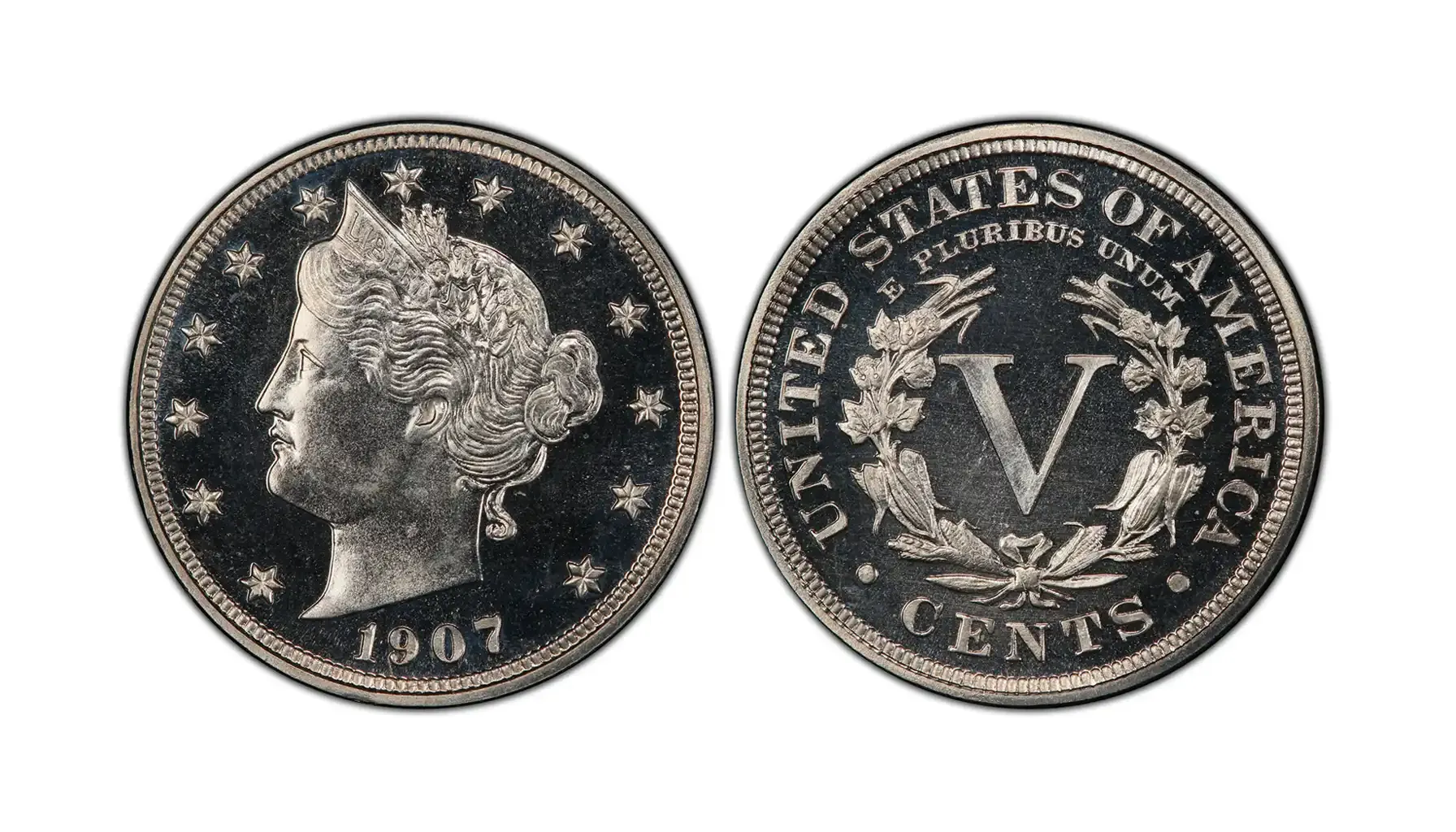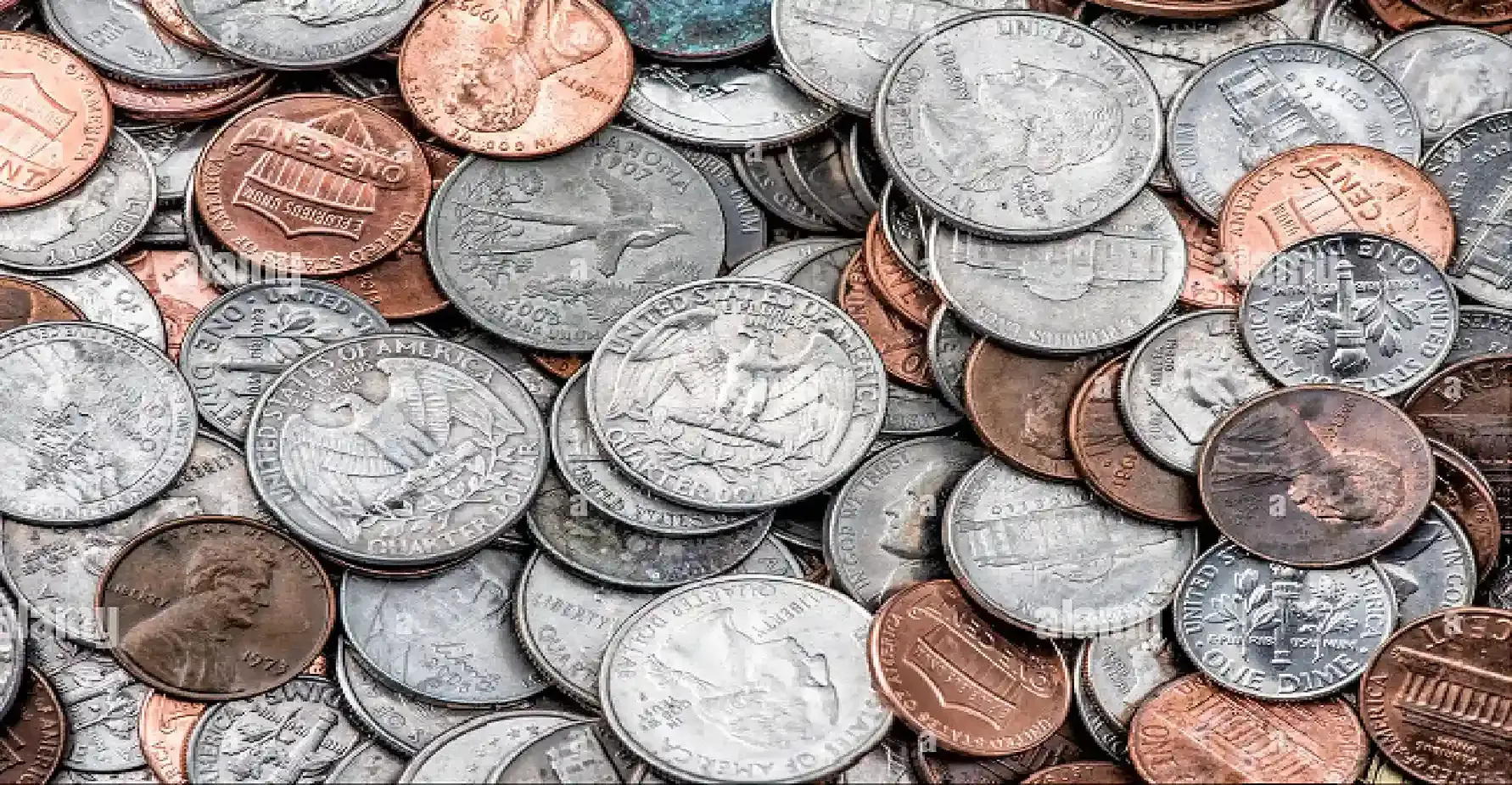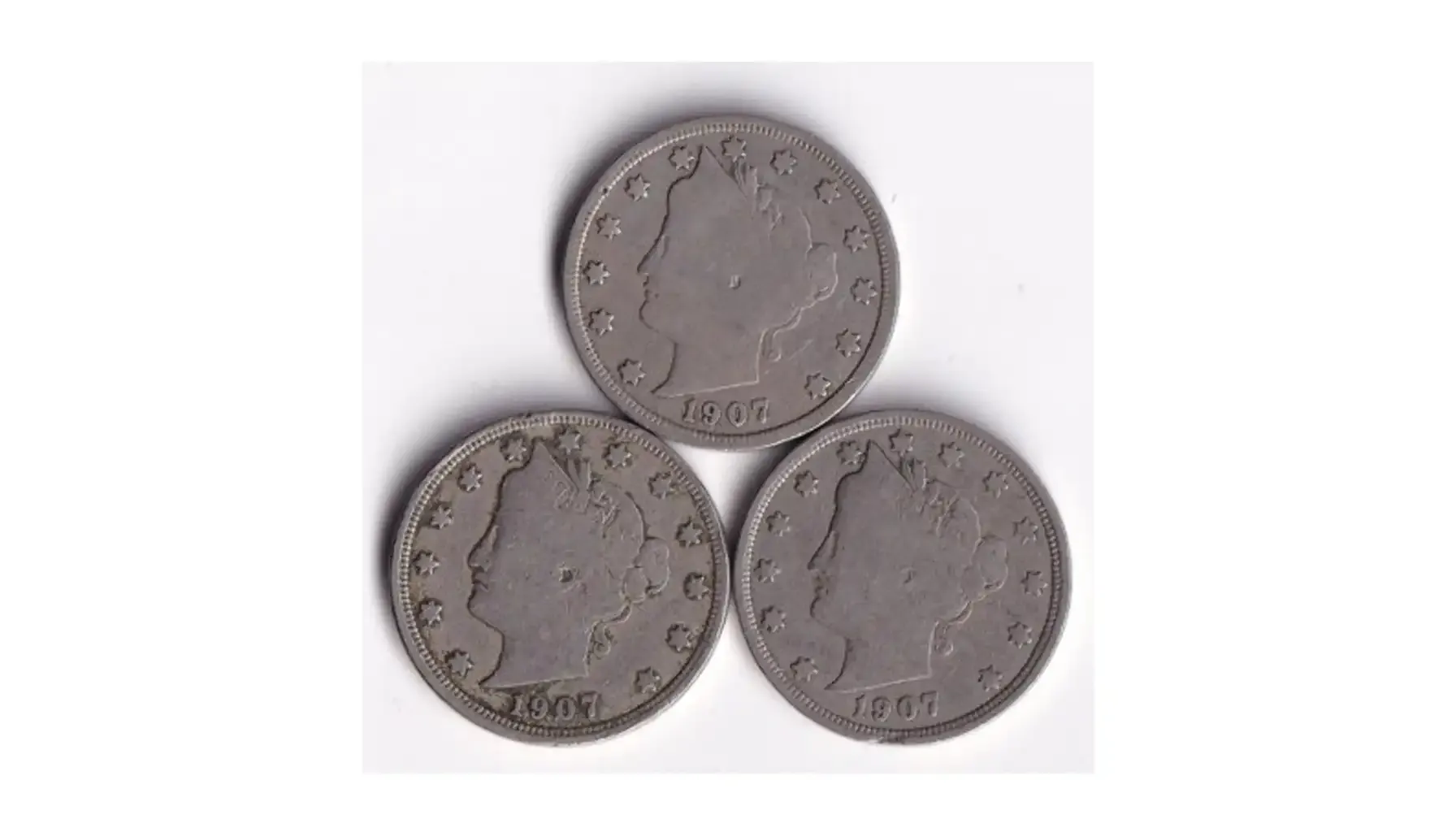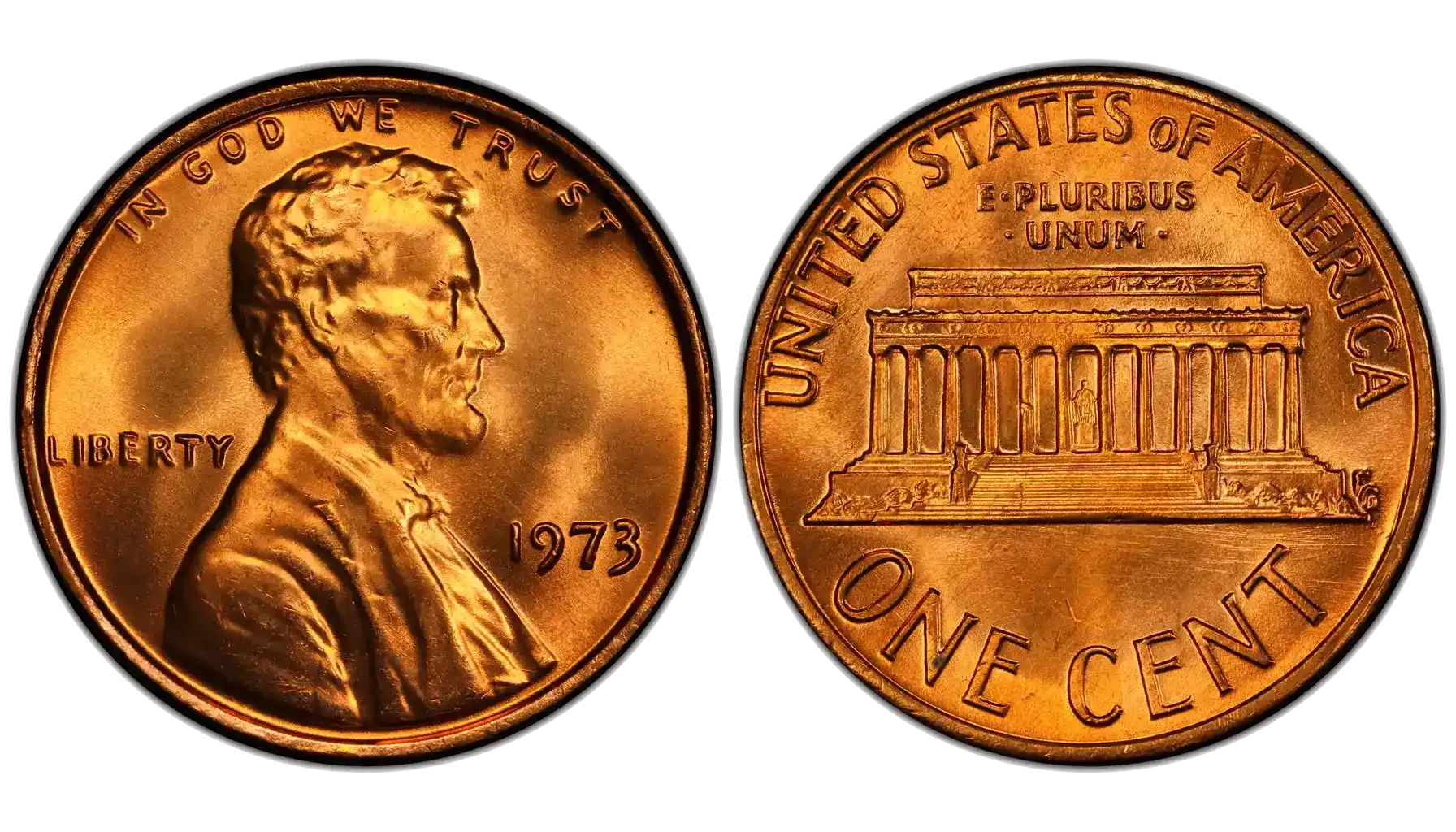Contents:
Old coins are often seen as valuable simply because of their age. However, their true worth goes beyond years. It lies in their historical context, metal composition, visual appeal, condition, and other unique traits. And the more distant the coin is, the more blurred its distinctive constituents get – the truth that misleads numismatic enthusiasts at the start of their career.
Should you stumble upon the 1907 Liberty nickel, it is to instantly captivate with its design and the year of production (which happened to be too far away from us and our contemporaries). But what else identifies this coin as unique? What is the true 1907 Liberty Head nickel value? And which varieties to look for?

History of the 1907 Liberty Head Nickel
The 1907 nickel refers to the Liberty Head nickel series (i.e., 5-cent coins), which started with the launch of the 1883 nickel and approached its final year with the 1913 nickel release. 1907, i.e., the year which is the object of our interest today, marked the looming end of the legendary series, designed by Charles E. Barber.
The year 1907 was the second-highest mintage of the entire Liberty Head series, with over 39 million coins produced by the Philadelphia Mint alone. In fact, these coins were widely utilized in commerce, which is why instances in pristine condition can be barely found. The rising demand for nickels, facilitated by the blooming economy and the expansion of “coin-powered” machinery, literally forced the mints to produce more and more samples, meeting the needs of the general public.
However, the age of the “V” nickels was not overly long. The Liberty Head nickel series was to be replaced by the Buffalo nickel in 1913, since the US Mint and the government strived to introduce more artful, peculiar pieces for a new century to unfold.

How to Identify a 1907 V Nickel?
The 1907 nickel with V on the back is a classic piece of American coinage widely known and cherished (even on the international level). Having it in a collection is a sign of good numismatic taste, yet in order to obtain it, it is vital to understand its specific design features and physical characteristics. These are the key elements of the coin that may help you distinguish it from other nickels or fakes.
Obverse: The obverse features a portrait of Lady Liberty facing left and wearing a coronet inscribed with the word “LIBERTY,” along with the thirteen stars encircling the portrait along the rim, and the date “1907” displayed below Liberty’s profile.
Reverse: On the reverse, one may see a large Roman numeral “V” (representing the denomination of five cents) at the center, encircled by a wreath made of corn, wheat, maple leaves, and cotton, with the inscriptions “UNITED STATES OF AMERICA” along the top edge, the motto “E PLURIBUS UNUM” above the “V,” and the word “CENTS” beneath.
The Main Features of the 1907 Nickel | |
Series Start | 1883 |
Series End | 1913 |
Denomination | 5 cents |
Composition | 75% copper, 25% nickel |
Diameter | 21.2 mm |
Weight | 5.0 grams |
Thickness | Approximately 1.95 mm |
Edge | Plain (smooth, without reeds) |
Mint Mark | None (Philadelphia Mint issues only) |
Designer | Charles E. Barber |
Year of Issue | 1907 |
To learn more about specifications, you are free to refer to Coin ID Scanner, an innovative application that helps identify, grade, and evaluate coins using your phone camera only. It is free, though.
Common Variations of the 1907 Victory Nickel
1907 5C (Regular Strike)

Produced by: Philadelphia Mint
Mintage: 39,213,325
Auction Record: $19,975 for MS67
According to Ron Guth, the 1907 Liberty V nickel boasts the second largest mintage in the entire series and was, at that time, the largest mintage for any nickel ever produced. Despite this impressive number, Guth notes that the 1907 nickel is not any more common than its contemporaries, nor does it typically appear in better condition than other years.
1907 5C (Proof)

Produced by: Philadelphia Mint
Mintage: 1,475
Auction Record: $26,400 for PR67+CAM
Ron Guth also highlights that the 1907 US nickel in proof version has the smallest mintage of any date in the series (unlike its regular counterpart). However, he points out that the coin remains relatively common among Proof collectors because the greatest part of the original 1,475 pieces still exist. Besides, while Deep Cameo examples have yet to be found and may not exist, Cameo versions are known to survive.
Grading Insights: What Affects the 1907 V Nickel Value?
As is customary, the 1907 V nickel worth depends on one obvious factor, namely, condition (or grade), which reflects how much wear the coin has experienced over time. As a rule, coins are graded on a scale from Poor (P1) to Mint State (MS70). This means that the higher the grade, the sharper and more detailed the design, and the more valuable the coin becomes. This is not only about the mint that released the coin or strike type, but the quality in which it is presented in the end.
Here are the main factors that influence grading and, consequently, the value:
Wear and Detail Loss: Look for wear on Liberty’s hair, the coronet, and the wreath on the reverse.
Strike Quality: Strong, well-defined strikes are more valuable than weak or uneven ones (not to be confused with errors like doubled dies, off-center strikes, or RPMs, which only boost the value for good).
Luster and Eye Appeal: Coins with original mint luster and minimal discoloration are graded higher.
Surface Preservation: Fewer nicks, scratches, and spots mean a higher grade.
Professional grading by services like NGC or PCGS usually provides one with relevant certificates reflecting the encapsulated coin's quality. This is how one may solidify the worth and add credibility to the items in their collections.

Tip: If you are unsure of your coin’s grade and wish to get a preliminary evaluation, you can always use apps like Coin ID Scanner to get an instant assessment for free.
Market 1907 Nickel Value Today: What You Can Expect
How much is a 1907 nickel worth? The current numismatic market is as complex as it seems at first. Relevant information found there may only reflect how diverse samples can be and how strongly the subjective factors affect the worth in the end. While circulated regular strike coins can be found for just a few dollars, high-grade Mint State examples can sell for hundreds (and sometimes thousands) of dollars, depending on eye appeal, rarity, and certificates provided.
Anyway, the demand for old numismatic creations like the hero of the article is constantly high, and this makes them even more valuable over time. So, how much is a 1907 V nickel worth?
Grade | 1907 5C Regular Strike | 1907 5C Proof Strike |
Good (G-4) | $2–$3 | — |
Fine (F-12) | $4–$6 | — |
Extremely Fine (EF-40) | $15–$25 | — |
About Uncirculated (AU-50) | $30–$45 | — |
Mint State (MS-60) | $85–$100 | — |
Mint State (MS-65) | $450–$600 | — |
Mint State (MS-67) | Up to $19,975* | — |
Proof (PR-60) | — | $190–$240 |
Proof (PR-65) | — | $600–$900 |
Proof (PR-67 CAM) | — | Up to $26,400* |
*Auction records as noted; actual values depend on certification, luster, strike quality, and market trends.
Interesting Facts That May Surprise You
Shield Nickel Struggles: Before the Liberty Head series, there were used the Shield Nickels. Though visually intricate, their design posed technical problems during minting. Despite early plans to replace it as far back as 1867, the coin remained in circulation for over two decades.
Design Oversight Led to Fraud: The first Liberty Head nickels lacked the word “CENTS,” showing only a large “V” for value. This small omission created a big opportunity: fraudsters gold-plated the coins and passed them off as $5 gold pieces. Some even added reeded edges to make them more convincing!
Forced Redesign: Due to widespread counterfeit activity, the US Mint quickly revised the design and added the word “CENTS” beneath the V to stop the deception and clarify the coin’s value.
The Mystery of 1913 Nickels: The last coins are always the most precious. Even though the Liberty Head series officially ended in 1912 with the 1912 Liberty Head nickel, five unauthorized 1913 nickels were somehow minted. Today, they are among the most desirable numismatic pieces in the United States!
Collectibles are fun to look for. They are often the pieces of American history that cannot be erased. So, do not underestimate relics of the past – what if your coin holds something more prominent than its face says?



